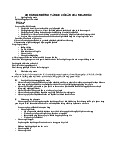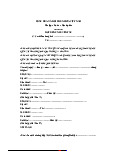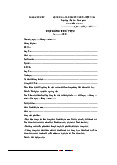













Preview text:
CHAP 1
1. Which of the following statements is true of human capital?
a. Human capital is an organization’s tangible asset.
b. Motivation to deliver high-quality products and services is a part of human capital.
c. It is easy to imitate or purchase an organization’s human capital.
d. Human capital is standardized in companies.
2. Informal learning _____.
a. is developed and organized by a company
b. is not required for the development of human capital
c. cannot be controlled by the employees
d. leads to the effective development of tacit knowledge
3. Which of the following is true of tacit knowledge?
a. It is easily codified and transferred from person-toperson.
b. Formulas and definitions are examples of tacit knowledge.
c. It is best acquired through formal training and development
d. It is best acquired through informal learning.
4. _____ is an example of tacit knowledge.
a. Personal knowledge based on experience
b. Knowledge of formal processes c. Knowledge of definitions d. Knowledge of formulas
5. _____ refers to a systematic approach for developing training programs. a. Total quality management b. Continuous learning
c. The training design process
d. Orientation training program
6. Which of the following statements is true of the Instructional System Design (ISD) model?
a. The model is generally universally accepted.
b. The model specifies an orderly, step-by-step approach to training design.
c. The model eliminates the need for trainers to use their own judgment.
d. The model has no underlying assumptions
6.1 _____ refers to the process of collecting the outcomes needed to determine whether training is effective.
a. Training evaluation; b. Program design c. Performance appraisal; d. Needs assessment
6.2.Which of the following statements best differentiates formative evaluation from summative evaluation?
a. Formative evaluation mainly involves collecting quantitative data, whereas summative evaluation
involves collecting qualitative data.
b. Formative evaluation takes place on the completion of training, whereas summative evaluation takes
place during program design and development.
c. Formative evaluation focuses on how to make a training program better, whereas summative
evaluation helps to determine the extent to which trainees have changed after training.
d. Formative evaluation includes measuring the monetary benefits that a company receives from a training prog
6.3. Formative evaluation involves collecting data about a training program from trainees mainly through _____.
a. their opinions and feelings about the program;
b. measures of performance such as volume of sales
c. tests and ratings of their behavior; d. return on investment (ROI)
6.4.The evaluation process ideally begins with _____.
a. developing outcome measures;
b. choosing an evaluation strategy
c. developing measurable learning objectives; d. conducting a needs analysis
6.5._____ relate to whether trainees are using training content back on the job.
a. Reactions ; b. Learning; c. Cognitive outcomes; d. Behavior and skillbased outcomes
6.6.Which training outcome relates to trainees providing feedback about their satisfaction with a trainer?
a. Results ; b. Cognitive ; c. Reactions ; d. Behavior and skill-based
6.7._____ relate to trainees’ attitudes toward training content and motivation to transfer.
a. Reactions b. Affective outcomes ; c. Cognitive outcomes ; d. Behavior and skill-based outcomes
6.8.Front-line supervisors are likely most concerned with which training outcomes?
a. Reactions ; b. Return on expectations (ROE) ; c. Cognitive outcomes ; d. Behavior and skill-based outcomes
6.9.Behavior and skill-based outcomes are best measured by _____.
a. Surveys ; b. interviews; c. focus groups; d. observations
6.10. Typically, _____ are used to assess cognitive outcomes.
a. attitude surveys; b. observations; c. focus groups d. pencil-and-paper tests
6.11. Which of the following is an affective learning outcome?
a. Learners’ satisfaction with training; b. Greater appreciation of diversity; c. Increased production; d. Reduced costs of production
6.12. If a firm measures its sales volume before and after a training program, which training outcome is it focused on?
a. Reactions; b. Return on expectations (ROE) c. Return on investment (ROI); d. Results
6.13. _____ refers to the ease with which training outcomes can be collected.
a. Reliability ; b. Practicality ; c. Acceptability; d. Relevance
6.14.Appropriate training outcomes need to discriminate. This means that _____.
a. tests given to employees before and after a training program should differ
b. trainees should be asked to take a reliable test that includes items for which the meaning or
interpretation change over time
c. trainees’ performance on the outcome should actually reflect true differences in performance
d. different employees should be given different tests for measuring their performance on the same outcome
6.15.If trainers are interested in the generalizability of a study’s results to other groups of employees,
then they are said to be interested in the _____ of the study.
a. outcome practicality; b. criterion relevance; c. external validity; d. outcome believability
7.1 ___Learning focuses on well-defined compentencies typically trained and online methods
a. Guided competency b.Social competency learning
c. Guided contextual learning d. Social contextual learning
7.2 ___focuses on context dependent knowledge and skills learned via social media and informal
interactions through others .
a. Guided competency b.Social competency learning
c. Guided contextual learning d. Social contextual learning
7.3 ___ Is an example of a context-based learning method that is guided by companies
a. Lecture b.Mentoring c.Coaching d.A simulation
7.4.Which of the following is a presentation method of training?
a.On-the-job training b.Lecture c.Simulation d.Case study
7.5.Lecture as a presentation method _____.
a. emphasizes active trainee involvement and feedback
b.is an expensive and time-consuming way to communicate information
c.can be easily employed with large groups of trainees
d.allows for strong connection to the work environment and easy transfer of training
7.6.Which of the following requires the least amount of participation from trainees?
a.Apprenticeship b.Case study c.Simulation d.Audiovisual instruction
7.7.Which of the following statements is most true of on-the-job training (OJT)?
a.It is formal because it should be planned.
b.OJT cannot be used for training newly hired employees.
c.Skills learned through OJT are easily transferred to the job.
d.OJT results in higher audiovisual costs
7.8.Which of the following methods allows employees to take responsibility for all aspects of learning,
including when it is conducted and who will be involved in it?
a.Self-directed learning b.Adult learning c.Apprenticeship d.Informal learning
7.9.Development of effective self-directed learning typically begins with _____.
a.writing trainee-centered learning objectives directly related to the tasks
b.conducting a job analysis to identify the tasks that must be covered
c.developing content for the learning package
d.developing an evaluation package
7.10.Which of the following training methods involve assisting a certified tradesperson at a work site?
a.Apprenticeships b.Simulations c.Business games d.Role plays
7.11.A case study _____.
a.is a training method that replicates the physical equipment
b.is a description about how employees or an organization dealt with a difficult situation.
c.involves assisting a certified tradesperson
d.involves observing peers performing a case and then trying to imitate their behavior
7.12.Which of the following is not characteristic of case studies?
a.They often depict realistic situations
b.They allow trainees to analyze situations and make recommendations
c.They allow trainees to act out skills
d.Trainees’ recommendations are hypothetical
7.13.Which of the following statements is true of business games?
a.Business games are non-competitive.
b.Trainees know for certain the consequences of their actions.
c.There are no limitations for participant behavior in business games.
d.Several alternative courses of action are available to trainees.
7.14._____ is based on the principles of social learning theory.
a.Behavior modification b.Simulation c.Behavior modeling d.Social media learning
7.15.Vicarious reinforcement is most relevant to _____.
a.Simulations b.behavior modeling c.case studies d.lectures
7.16.Which of the following is the first stage of an experiential learning training program?
a.Take part in a behavioral simulation b.Analyze the activity
c.Gain conceptual knowledge and theory
d.Connect the theory and activity with on-the-job or real-life situations
7.17._____ refers to the training that a team manager receives that focuses on ways to resolve conflict within the team.
a.Guided team self-correction b.Scenario-based training c.Team leader training d.Cross training
7.18._____ best prepares team members to step in and take the place of a member who may
temporarily leave the team.
a.Guided team self-correction b.Cross training c.Coordination training d.Temporary team training
7.19._____ involves training teams how to share information and make decisions.
a.Cross training b.Team sharing training c.Coordination training d.Guided team self-correction
7.20. _____ is a group building method that may include customers and addresses problems such as
how to change the business and develop global leaders.
a.Action learning b.Adventure learning c.Cross training d.Guided team self-correction
8.1. Which of the following statements is true of technology’s influence on training and learning?
a.New technologies have increased the administrative costs associated with delivering training.
b.New training technologies will totally replace face-to-face instruction.
c.New technologies give employees access to and control of their own learning through relationships
and collaborations with others.
d.New technologies have made training less lifelike.
8.2._____ allow synchronous communication in training.
a.Live online courses b.Self-paced courses on CD-ROMs c.Virtual libraries d.E-mails
8.3.Which of the following is not true regarding the effectiveness of online learning?
a.Online instruction is more effective than face-to-face learning for declarative knowledge.
b.Online instruction is better than classroom instruction for procedural knowledge.
c.Trainees who benefit most are those who take more time and practice more.
d.Online learning is not effective for all learners, particularly those with low computer selfefficacy.
8.4.Which of the following is a disadvantage of online learning?
a.Some trainees may not be motivated to learn through technology.
b.Online learning is ineffective for training that emphasizes cognitive outcomes.
c.Online learning fails to link learners to other content, experts, and peers.
d.Updating online learning is extremely difficult.
8.5.To create a positive online learning experience, _____.
a.content that is unrelated to the learning objectives should be included
b.the use of multiple types of media should be avoided as they may be distracting
c.there should be prompts to promote self-regulation
d.modules should be fairly long to promote overlearning
8.6._____ refers to directly translating an instructor-led, faceto-face training program to an online format.
a.Repurposing b.Rapid prototyping c.Self-directedness d.Webcasting
8.7._____ refers to the learner’s involvement with the training material and assessing their progress toward learning.
a.Repurposing b.Rapid prototyping c.Metacognition d.Selfregulation
8.8.Online training is best provided _____.
a.during the trainees’ personal time
b.during breaks in the trainees’ normal workday
c.at the employee’s desktop without time away from the job
d.with one- to two-hour training modules rather than a full-day training session
8.9.YouTube is a typical example of _____.
a. a shared workspace b. shared media c. a microblog d. an online chat room
8.10.A _____refers to software tools that enable communication in short bursts of text, links, and
multimedia through stand-alone applications or through online communities
a.Blog b. wiki c. microblog d. shared media
8.11.The use of social media as a learning tool will be ineffective in a company that _____.
a.has a significant number of Millennials
b.requires substantial teamwork
c.requires centralized decision making
d.has geographically dispersed employees
8.12.Which of the following is not a benefit of MOOCs? a. Completion rates are high.
b. They are low cost, accessible, and cover a wide range of topics.
c. Learning happens through engaging short lectures combined with interaction with the course
material, other students, and the instructor.
d. They emphasize applying knowledge and skills using role plays, cases, and
8.13.In comparison to classroom delivery, blended learning has increased _____.
a.involvement of the instructors b.face-to-face interactions
c.self-directedness among employees
d.learner’s dependency on the instructor
8.14.In a(n) _____ type of simulation, trainees are presented with a situation and asked to make a
decision that enables them to progress through the simulation.
a.decision-making b.branching story c.virtual lab dinteractive spreadsheet
8.15. In a virtual lab type of simulation, trainees _____.
a.interact with a computer representation of the job for which they are being trained
b.are given a set of business rules
c.enter their decisions into a spreadsheet that shows how the decisions affect the business
d.are presented with a situation and asked to make a choice or decision
8.16. The use of simulations has been limited by their _____.
a.inability to incorporate situations that a trainee might encounter
b.inability to be used on a desktop computer
c.need for employees to travel to a central training location d.high development costs
8.17.Which of the following is an advantage of simulations?
a.Simulations provide learning situations with a high degree of human contact.
b.Trainees do not have to acquire any prior knowledge while playing a game.
c.Simulations can safely put employees in situations that would be dangerous in the real world.
d.Compared to most other training methods, development costs are lower
The fifth step in the training design process is to develop an evaluation plan that involves identifying _____.
the types of outcomes training is expected to influence an appropriate training method
employees with motivation and basic skills the requirements for training
Which of the following steps of the training design process involves person and task analysis? Conducting needs assessment Developing an evaluation plan
Monitoring and evaluating the program Ensuring transfer of training
The final step of the strategic training and development process involves _____.
creating concrete training and development activities
choosing strategic training and development initiatives
identifying the business strategy
identifying measures or metrics
Which of the following is true about a learning organization?
In a learning organization, employees are discouraged from asking questions and admitting mistakes.
A learning organization discourages learning at the group and organizational levels.
A learning organization restricts employees from experimenting with products and services.
In a learning organization, employees learn from failure and from successes.
_____ relates to intellectual capability and general intelligence. Self-efficacy Reading ability Basic skills Cognitive ability
_____ refers to the process of a company using information about other companies’ training practices Benchmarking Crowdsourcing Brainstorming Outsourcing
Uniqueness refers to _____.
the extent to which training and learning is centralized in an organization
the extent to which employees are rare, specialized, and not highly available in the labor market
employee potential to improve company effectiveness and efficiency
the picture of the future an organization wants to achieve
Which of the following methods is inexpensive and allows the collection of data from a large number of individuals? Survey Focus group Interview Observation
_____ helps to identify who needs training, involves determining what is responsible for the
differences between employees’ current and expected performance. Person analysis Organizational analysis Task analysis Performance analysis
Which of the following is not one of the four major components of the balanced scorecard? Financial Sustainability Customers Internal business processes
Which of the following issues is addressed by task analysis?
Should training be built or bought?
Does training support the company’s strategic direction? What is the focus of training? Who needs training?
Which of the following statements is true of closed skills?
They refer to training objectives that are linked to general learning principles.
They are more difficult to train than open skills.
They require the trainee to adapt the general principles to fit a wide range of circumstances.
They refer to skills that are to be identically produced by the trainee on the job.
Companies that emphasize innovation and creativity are labeled as _____. baseball teams fortresses academies clubs
The strategic training and development process begins with _____.
choosing strategic training and development initiatives
identifying measures or metrics
identifying the business strategy
developing websites for knowledge sharing
_____ analysis involves determining the appropriateness of training, given the company’s business
strategy, its resources available for training, and support by managers and peers. Task Value-chain Organizational Gap
Which of the following statements is true of needs assessment?
The role of the needs assessment is to determine if training is the appropriate solution.
A company’s decision regarding outsourcing its training is independent of needs assessment.
The needs assessment process fails to provide information regarding the outcomes that should be
collected to evaluate training effectiveness.
Upper- and mid-level managers are excluded from getting involved in the needs assessment process.
Which of the following is not one of the major reasons organizations outsource training? Desire for greater control Time savings Potential cost savings
Desire to access best practices
If training emphasizes total group discussion with limited presentation and no small-group interaction,
a _____ seating arrangement will be most effective. horseshoe classroom-type fan-type conference-type
_____ refers to the use of information by employees to determine their career interests, values,
aptitudes, and behavioral tendencies. Reality check Action planning Goal setting Self-assessment
Which of the following is not an exercise typically found in assessment centers? Interviewing skills training Role play Leadership group discussion In-basket exercises
A _____ refers to an organized program of study designed to meet a complex learning objective. training map lesson plan course curriculum
In training, the greatest level of support that a manager can provide is to _____.
allow trainees to attend training
discuss progress of the training sessions with trainees
participate in training as an instructor
provide trainees opportunity to practice what they have learned
In the _____ stage of the career management process, employees receive information on how the
company evaluates their skills and where they fit into the company’s plans. reality check action planning goal setting self-assessment
The pre-training phase primarily involves _____.
preparing a concept map and curriculum road map to facilitate learning
preparing, motivating, and energizing trainees to attend the learning event
preparing instruction (classes, courses, programs, lessons) to facilitate learning
encouraging learners to apply what they have learned to their work




